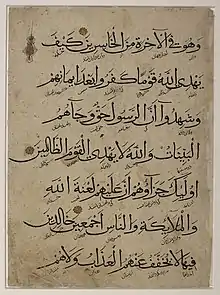
Qur'an verse 3:85-88 written in tawqi‘ with Persian annotations in naskh (14th century)
Tawqi‘ (Arabic: التوقيع, romanized: al-tawqī‘) is a calligraphic variety of the Arabic script. It is a modified and smaller version of the thuluth script. Both scripts were developed by Ibn Muqlah.[1] The tawqi‘ script was further refined by Ibn al-Bawwab.[2]
It was mostly employed in official state papers and documents in the Ottoman Empire, where the script was known as tevki.
References
- ↑ "Ibn Muqlah". Encyclopædia Britannica. Archived from the original on 22 November 2015. Retrieved 21 November 2015.
- ↑ "Ibn al-Bawwab". Encyclopædia Britannica. Archived from the original on 22 November 2015. Retrieved 21 November 2015.
Wikimedia Commons has media related to Tawqi' style.
This article is issued from Wikipedia. The text is licensed under Creative Commons - Attribution - Sharealike. Additional terms may apply for the media files.
